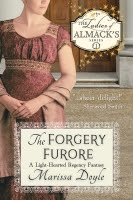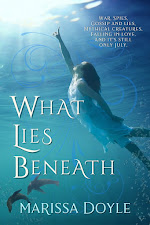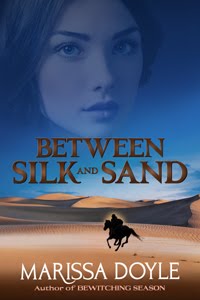A lot of things, as it turns out. 1811 was a banner year for fashion in my opinion because of the all the lovely variations that occurred in women's clothing. No one style predominated, as we'll see happens in later years. For example, look at these high-waisted Evening Dresses from the January 1 edition of Ackermann's Repository (don't you love the way the artist sneaks in a back view?):

But just a couple of months later, this Opera Dress ensemble shows an open jacket-like garment that sits at the natural waist (Ackermann's Repository, March 1):

And there's no waist at all in this Carriage Dress, also from the March 1 edition:

Primrose yellow was definitely in, as can be seen in this sprightly, spring-like, and also waist-less Ball Dress from April 1's Ackermann's:

As in the first image, the focus is on the bust in this pretty pink Full Dress, set back at the natural waist (May 1, Ackermann's Repository):

This elegant Riding Habit also sits at the natural waist. Note the length of the skirt in back, meant to drape gracefully once the rider was ensconced in her side-saddle (Ackermann's Repository, October 1):

Similar to the Opera Dress from March with its yellow over-dress, here's a Walking Dress from October 1st's Ackermann's:

I love this next dress because it is comfortable-looking and handsome...but would you have guessed 1811? (Evening Dress, October 1, Ackermann's Repository):

Again, I think this Walking Dress could have as easily hailed from 1911 as 1811 (and oh-so-cozy with that ermine lining! November 1, Ackermann's Repository):

Equally cozy and charming is this Carriage Dress from November 1's Ackermanns:

Closing out this year of elegance is a Mourning Dress (though I've been unable to figure out for whom mourning was ordered.) I have the descriptive text for this December 1st Ackermann's plate: "A round robe of fine iron-grey cloth or velvet, with long sleeves and demi-high front, trimmed down the center of the figure, at a measured distance, with chenille fur, and clasped in the center, from the bosom to the feet, with lozenge clasps of jet; the belt confined with the same. Antique scolloped ruff of white crape; cuffs to correspond. Hungarian mantle, with double capes, trimmed with chenille fur, composed of the same material as the robe, and ornamented with rich cord and tassels at the throat. A small Eastern turban of grey and silver tissue; short willow feathers (alternately grey and white) drooping on the left side. Ear-rings and neck-lace of jet. Gloves of grey or white kid. Slippers of black queen silk, with jet clasps. Fan of black crape, frosted with silver.--This dress is furnished us by Mrs. Gill, Cork-Street, Burlington Gardens."

What do you think of 1811's clothes?












 "This very elegant floating bath is stationed near the north end of the Waterloo-bridge, and has recently been built and completed with entirely new and substantial materials, in a style of superior accommodation, at a very considerable expense: it contains a plunging bath, 24 feet long by 8 feet wide, and two private baths, 10 feet long by 8 feet wide. The depth may be regulated at pleasure by machinery, which raises or depresses the bottom as required, secured by cross timbers, and bound with iron. To each of the baths are attached small dressing rooms, commodiously fitted up, with proper persons to attend upon visitors. These baths are so constructed, that the water, being a running stream, is changed every two minutes. The advantage of bathing in a flowing stream is obvious, and gives a decided preference over a cold still bath, which is frequently dangerous from the violence of the shock. The terms of bathing, as our readers will see, are extremely moderate:--they are--
"This very elegant floating bath is stationed near the north end of the Waterloo-bridge, and has recently been built and completed with entirely new and substantial materials, in a style of superior accommodation, at a very considerable expense: it contains a plunging bath, 24 feet long by 8 feet wide, and two private baths, 10 feet long by 8 feet wide. The depth may be regulated at pleasure by machinery, which raises or depresses the bottom as required, secured by cross timbers, and bound with iron. To each of the baths are attached small dressing rooms, commodiously fitted up, with proper persons to attend upon visitors. These baths are so constructed, that the water, being a running stream, is changed every two minutes. The advantage of bathing in a flowing stream is obvious, and gives a decided preference over a cold still bath, which is frequently dangerous from the violence of the shock. The terms of bathing, as our readers will see, are extremely moderate:--they are--





